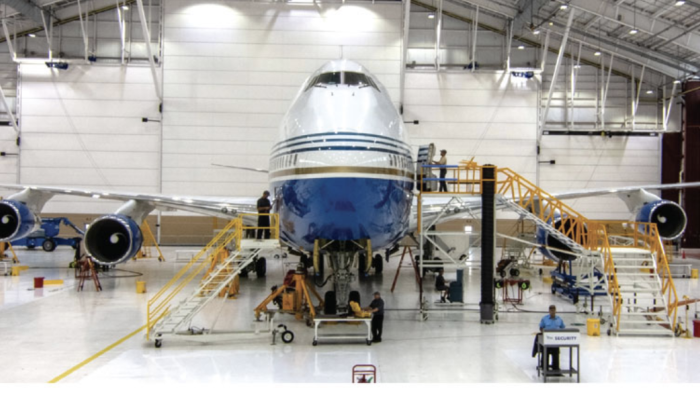Marshall Aerospace and Defence, based in Cambridge, England, has started to use additive manufacturing—also known as 3D printing—to make aerospace components certified for in-flight aircraft interior applications. The components are manufactured on a Stratasys (Hall 4 Stand D192) Fortus 450mc machine using a tough resin material called ULTEM 9085 that meets flame, smoke, and toxicity requirements.
Parts made so far include ductwork for what the company will only identify as a special missions aircraft, and an emergency knife-holder and thumb switch fitted to the control column to operate chaff and flare defensive measures for a Lockheed C-130 Hercules of the Royal Air Force.
The machine employs a process known as fused deposition modeling (FDM) in which the resin is heated to more than 200 deg C and then extruded in molten form to manufacture parts layer-by-layer without any requirement for a mold to be machined beforehand. As a result, not only are lead-times cut from what might otherwise be weeks or months to just a few days, but so are costs. Part cost is also independent of the numbers involved so there is no financial penalty for the low-volume production requirements associated with aircraft maintenance, repair, or modification.
According to engineering director Stuart Hossack the company received approval from EASA in February last year to use the machine to make parts for in-flight use. He confirmed that the first flight-certified additively manufactured part made by the company—which was in fact the thumb switch—took to the air in May 2018. By the same time this year, he said the company had used the process to make a total of 14 different part types for in-flight use, with the actual number of individual parts numbering more than 20. All the parts involved have been designed by Marshall Aerospace.
Speed of design iteration is another important factor. In the case of the thumb switch, for instance, the company reported that after alterations to an initial configuration were requested, the whole process of amending the design and printing out a new approved part was completed within a single day.
Marshall’s use of additive techniques also extends to making parts for on-ground operations and development prototyping applications. These can involve the use of a second Stratasys FDM machine at the site—an F370 3D printer—which, though not certified to produce parts for in-flight use, is again described as making a significant contribution to streamlining design and development procedures.
One example in which the 450mc machine was used led to a complete material replacement in the final part. This was for the production of a prototype ducting adapter used to provide cooling air to an aircraft’s avionics while it is on the ground.
The initial intention had been to print a prototype in a thermoplastic material to validate the design before machining the final part in aluminum. But according to Marshall Aerospace additive manufacturing engineer Chris Botting, the prototype worked so well that the final part was instead 3D printed in a nylon material. As well as providing a significant cost reduction compared to machining the part out of aluminum, he said the new part also provided a 63 percent reduction in overall weight.
Elsewhere, 3D printing has also been used as a prototyping tool even where material replacement has not been an option. It was used, for instance, to create a full-size model of a housing for a missile warning sensor being fitted as a modification to the front fuselage of a Hercules.
That model was used to test the form and fit of the final part, which necessarily had to be machined from aluminum. The company said that this exercise successfully derisked the manufacture of the housing, which then fitted exactly, first time, with no need for further machining.







